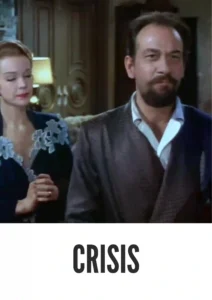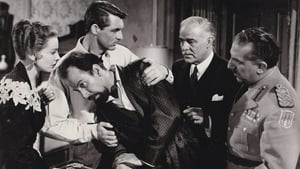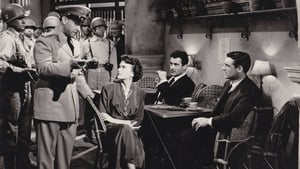Contact: [email protected]
Video Sources 0 Views
- Watch trailer
- Crisis


Synopsis
Table of Contents
ToggleReview: Crisis (1950) – A Gripping Political Drama with a Human Touch

Introduction
Crisis, released in 1950, is a captivating political drama that delves into the complexities of power, morality, and human resilience. Directed by Richard Brooks, this film combines suspenseful storytelling with poignant character development to create a thought-provoking cinematic experience. In this review, we will explore the compelling narrative and enduring relevance of Crisis.
the film’s artistry, storytelling, and the unique experience of the early colored films version.
Check The Full Colorized Movies List
Check Our Colorized Movies Trailer Channel
Understanding Crisis (1950): Director, Cast, and Genre
Directed by Richard Brooks, Crisis boasts a talented cast led by Cary Grant in the role of Dr. Eugene Norland Ferguson, alongside José Ferrer, Paula Raymond, and Signe Hasso. The film falls within the genre of political drama, characterized by its exploration of social issues, moral dilemmas, and power dynamics.
Exploring the World of Crisis (1950): Plot and Characters
Set against the backdrop of an unnamed Latin American country, Crisis follows the story of Dr. Eugene Ferguson, an American doctor who becomes embroiled in a political conspiracy. As Dr. Ferguson navigates the dangerous waters of political intrigue and personal risk, he must confront his own beliefs and values in the face of corruption and injustice. Along the way, he forms unexpected alliances and discovers the power of compassion and courage in the fight for justice.
The Art of Film Colorization
While Crisis was originally filmed in black and white, its early colorized version adds a new layer of visual richness and depth to its atmospheric cinematography. The colorization process enhances the film’s evocative imagery and captures the vibrant energy of its Latin American setting with stunning clarity.
Early Colored Films: A Brief History
The history of early colored films is marked by innovation and experimentation as filmmakers sought to enhance the visual appeal of their movies. From hand-tinted frames to pioneering technicolor processes, the evolution of colorization techniques transformed the cinematic landscape, offering audiences a new way to experience classic stories and compelling characters.
Crisis (1950) and Its Early Colored Version
The decision to release Crisis in a colorized format was made with the intention of immersing audiences in the vibrant atmosphere of its Latin American setting and enhancing the film’s visual impact. While some purists may prefer the original black and white version, the early colorized edition of Crisis adds a new dimension to its atmospheric cinematography and captures the vibrant energy of its setting with breathtaking clarity.
The Debate Over Film Colorization
The debate over film colorization continues to divide audiences and industry professionals alike. While some argue that colorization breathes new life into classic films and makes them more accessible to modern audiences, others maintain that it compromises the artistic integrity of the original work. As technology advances and filmmaking techniques evolve, the debate over colorization remains a topic of ongoing discussion within the film community.
Examining Crisis (1950) as an Early Colored Film
Viewing Crisis in its early colorized iteration offers audiences a fresh perspective on its atmospheric beauty and vibrant setting. The colorization process enhances the film’s evocative cinematography and captures the vibrant energy of its Latin American setting with stunning clarity. As viewers are drawn into the world of political intrigue and personal sacrifice, they are treated to a visual feast that immerses them in the drama and suspense of the story.
Influence and Legacy: Crisis (1950)’s Impact on Cinema
Crisis is widely regarded as a classic example of the political drama genre that continues to captivate audiences with its gripping narrative and memorable characters. Its exploration of themes such as power, corruption, and personal integrity remains relevant in today’s world, making it a timeless classic that continues to resonate with viewers around the world.
Director’s Cinematic Legacy: Beyond Crisis (1950)
Richard Brooks’s directorial legacy extends far beyond Crisis, encompassing a diverse body of work that includes acclaimed films such as Cat on a Hot Tin Roof and In Cold Blood. As one of the most respected filmmakers of his generation, Brooks was known for his keen insight into human nature and his ability to tackle complex social issues with intelligence and nuance. Crisis stands as a testament to his talent and vision, solidifying his reputation as one of the great auteurs of classic American cinema.
Themes Explored in Crisis (1950)
At its core, Crisis explores themes of power, corruption, and personal integrity in the face of political turmoil. Through its gripping storyline and memorable characters, the film offers a nuanced portrayal of the human condition, challenging viewers to confront their own beliefs about right and wrong.
Reception and Controversy Surrounding Crisis (1950)
Upon its release, Crisis received widespread critical acclaim for its gripping narrative, compelling characters, and thought-provoking themes. While the decision to release the film in a colorized format sparked debate among purists, its enduring popularity has cemented its status as a timeless classic of American cinema.
Where to Watch Crisis (1950) Online
For those eager to experience Crisis for themselves, the film is readily available on popular streaming platforms such as Amazon Prime Video, Google Play Movies, and iTunes. Whether viewed in its original black and white format or its early colorized iteration, Crisis offers a cinematic experience that is both gripping and visually stunning.
FAQs About Crisis (1950)
1. Is Crisis based on a true story?
No, Crisis is a fictional film that explores themes of power, corruption, and personal integrity in the face of political turmoil. While the film’s storyline may draw inspiration from real-life events and historical figures, its characters and plot are works of fiction.
2. Who starred in Crisis?
Crisis stars Cary Grant as Dr. Eugene Norland Ferguson, alongside José Ferrer, Paula Raymond, and Signe Hasso. Their powerful performances bring depth and authenticity to the film’s gripping storyline, capturing the essence of political intrigue and personal sacrifice with remarkable skill.
3. What is the central message of Crisis?
At its core, Crisis explores themes of power, corruption, and personal integrity in the face of political turmoil. Through its gripping storyline and memorable characters, the film offers a nuanced portrayal of the human condition, challenging viewers to confront their own beliefs about right and wrong.
4. Why was Crisis released in a colorized format?
The decision to release Crisis in a colorized format was made with the intention of immersing audiences in the vibrant atmosphere of its Latin American setting and enhancing the film’s visual impact. While some purists may prefer the original black and white version, the early colorized edition of Crisis adds a new dimension to its atmospheric cinematography and captures the vibrant energy of its setting with breathtaking clarity.
5. What is the legacy of Crisis?
Crisis is widely regarded as a classic example of the political drama genre that continues to captivate audiences with its gripping narrative and memorable characters. Its exploration of themes such as power, corruption, and personal integrity remains relevant in today’s world, making it a timeless classic that continues to resonate with viewers around the world.
6. Are there any sequels or remakes of Crisis?
No, there have been no official sequels or remakes of Crisis. However, the film’s enduring popularity has inspired countless reinterpretations and adaptations in various media. Nonetheless, none have captured the gripping drama and thought-provoking themes of the original 1950 classic.
7. Where can I watch Crisis online?
For those eager to experience Crisis for themselves, the film is readily available on popular streaming platforms such as Amazon Prime Video, Google Play Movies, and iTunes. Whether viewed in its original black and white format or its early colorized iteration, Crisis offers a cinematic experience that is both gripping and visually stunning.
Conclusion
In conclusion, Crisis (1950) stands as a gripping political drama that delves into the complexities of power, corruption, and personal integrity. Whether viewed in its original black and white format or its early colorized iteration, Richard Brooks’s insightful direction and the powerful performances of the cast offer a cinematic experience that is both thought-provoking and visually stunning. As audiences grapple with the enduring relevance of its themes, Crisis remains a timeless classic that continues to captivate viewers with its gripping narrative and compelling characters.










